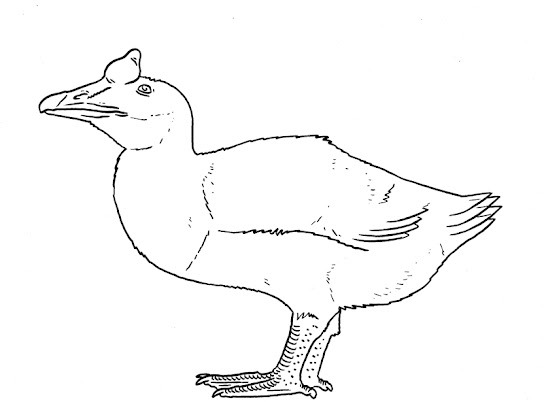Lake Ness Project - Tetrapods
Lake Ness - Amphibians, Reptiles, Birds, and Mammals
The Ness Dragon (Cryptobranchidae) is a very large kind of salamander, related to the Hellbender of North America. Reaching about 4.5 meters long, it is an ambush predator that lurks at various depths of the lakebed, though it avoids the deepest parts. It feeds commonly on slow-swimming fish, crustaceans, and other amphibians.
In the depths of the lakebed, in the abyss, lurks and even more remarkable amphibian. The Ness Lungless Frog (Ranidae) reaches the size of a large man, and sits motionless on the lakebed in ambush, crustaceans and fish being its main prey. This frog lacks lungs completely and never comes to the surface, breathing entirely by cutaneous respiration through its folded skin.
Turtles are a fairly common inhabitant of the shallows, both rather typical terrapins (Emyiade), but also the endemic Ness-snapper (Emyiade). This turtle reaches up to 1.7 meters in carapace length, and is a voracious ambush predator, common in shallower waters. Its diet consists mainly of fish, crustaceans and occasionally waterbirds and snakes.
A close relative of the Grass Snake (Colubridae) inhabits the margins of the lake but also areas further upland as well as the marsh. A formidable riverside snake, it can reach up to 3 meters long and commonly hunts in the shallows for fish.
The most anachronistic and charismatic of
The Boobrie (Alcidae) is a great species of Auk, found both in the Lake Ness, and in lochs and sea-lochs further to the south, down to the southern coast. At 1.5 meters tall, it is a formidable, flightless diving bird which feeds mostly on fish at various depths, and can dive fairly deep in search of oilier fish. This bird is very pugnacious and aggressive towards other animals and each other, and they do not breed in large colonies, being rather secretive when breeding. Its call is a half-bray, half-roar somewhere between a bull and an ass.
The Ness Fishing Shrike is a unique bird which may have evolved in response to the food provided by the lake. This magpie sized bird has a serrated bill and behaves much like a big kingfisher, snatching fish from the surface or diving into the water a short distance.
The Ness Eider (Merginae) is a common species of sea duck which is found both in the lake and the sea lochs and marshes further south. As big as a goose, it has a pear-shaped growth topping its head. As will all eiders, it feeds mainly on clams and mussels in the shallows, but will also feed on crayfish.
The margins of the lake, as well as the marshes further south, serve as habitat for the Lavellan (Soricidae), a kind of water shrew the size of a black rat. It dives in the shallows for fish and small crustaceans, subduing them with a venomous bite which is also used for defense.
The Wild-haggis (Erinaceinae) is an odd animal which was
once found extensively across Albion, but is now restricted to the lowland
hills on the shore of
Another odd creature common near
The Albion Otter (Lutrinae) is a very large species of otter, usually restricted to the North Sea shore and various sea lochs, but it is also found in some numbers in Lake Ness. These animals sometimes congregate in the water to form foraging groups, which may be mistaken for larger animals.
A common seasonal visitor from the North Sea to
The Cait-Sith or Kellas Cat (Felidae) is a species of
wildcat found in many parts of Albion but also near
The forested areas on the eastern Shore of Lake Ness play host to an unusual species of deer, whose evolutionary history is uncertain, as it almost resembles a camel as much as a deer, having a long neck and no antlers. This graceful animal, the Swan-deer (Cervidae, Longicollinae) is commonly seen coming down from the forest to the lake in order to drink, though it is usually shy. Similar in size and weight to a moose, it nevertheless differs greatly in the specifics of its anatomy. It is adapted mostly to browse forest trees for leaves, but it will sometimes dredge the shallows of the lake for plants.
The Tarb-Uisge is a local breed of cattle that dates back to the earliest days of Ox domestication. Bred to work on moors and coasts, it has a thick coat, and does well in wet, marshy conditions, though it has not been used as livestock in centuries and now runs wild. It is most common on the southern lakeshore and the marshes to the Southwest. It reaches a height of about .1.2 meters at the withers, somewhat smallish for a breed of ox, along with its generally white colouring, leading some folk to call them Fairy Cattle.
Similarly to the Tarb Usge is the Kelpie (Equus ferus caballus), is a strain of wild horse descended from originally domestic stock. This pony-like animal resembles many other breeds of domestic horse, but combines a large stature with a long coat and robust bone structure. They are notoriously fierce in temperament, and though are tempting to many to wish to tame, almost always resist such efforts. Coat colour is usually either black, white or white with black markings.
Albionian Bottlenose Dolphins (Tursiops, Delphinidae) are a
smallish kind of dolphin that inhabits parts of the North Sea and various sea
lochs to the south, as well as
I hope you enjoyed this new, Cryptozoologicon-style Project
All images, designs and writing on this blog are the property of Timothy Donald Morris, do not use, reproduce, or copy them without my permission.
© Timothy Donald Morris 2021





















Comments
Post a Comment